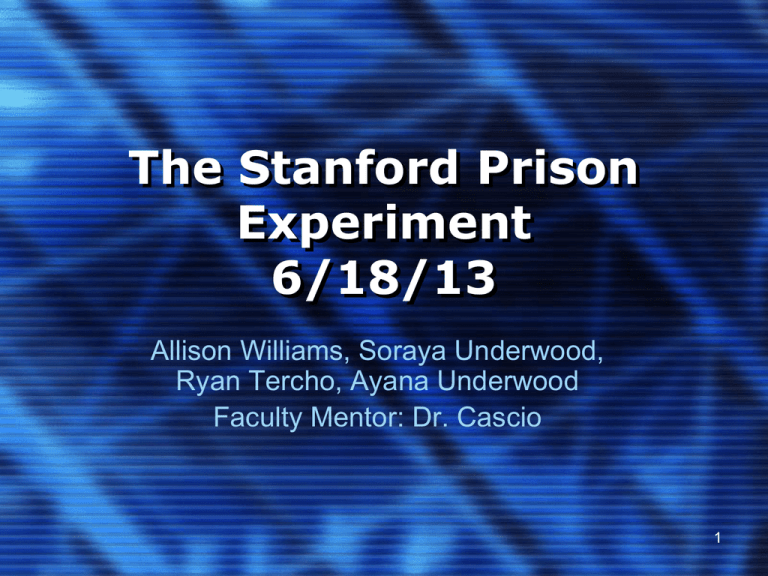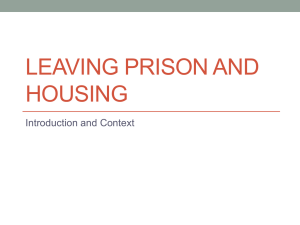
The Stanford Prison
Experiment
6/18/13
Allison Williams, Soraya Underwood,
Ryan Tercho, Ayana Underwood
Faculty Mentor: Dr. Cascio
1
Background
• The experiment was
performed in 1971
• The experiment was
overseen by Dr. Philip
Zimbardo
– PH. D. in Psychology
from Yale
• It was done in
connection with
Stanford University
Plous, Scott. "Philip G. Zimbardo." Social
Psychology Network. 17 Jan 2013. Web. 17 Jun
2013.
2
The Set Up
• The experiment
lasted 6 days
• It occurred in a mock
prison setting created
at the university
– Doors with bars, a
“yard area” etc.
Zimbardo, Philip. "Slide tour."
Stanford Prison Experiment.
2013. Web. 17 Jun 2013.
3
The People
• Sent out news paper
ads
• The experiment
involved 24 male
college students in
the Stanford area
Zimbardo, Philip. "Slide
tour." Stanford Prison
Experiment. 2013. Web. 17
Jun 2013.
4
The Experiment
• The men were split into
two groups: guards and
prisoners
• The prisoners were
taken from their house
in a “mock arrest”
– They were frisked and
searched upon entering
the mock prison
Zimbardo, Philip. "Slide tour." Stanford
Prison Experiment. 2013. Web. 17 Jun
2013.
• They were given an
informed consent form
that talked about
possible violation of
rights and minimal food
5
The Experiment (con.)
• Often times the prisoners
were put in uncomfortable
situations such as being
awakened at an
unreasonable hour or
physical punishment
• A rebellion developed
and this caused an even
more severe division
between the guards and
prisoners
• After the extensive abuse
and other variable
situations brought in, the
experiment was ended
Zimbardo, Philip. "Slide tour." Stanford
Prison Experiment. 2013. Web. 17 Jun
2013.
6
Principle A: Beneficence and Nonmaleficence
• Principle A states that psychologists must
take care of those they work with and thus
cause them no harm (1).
• It states that psychologists protect the
welfare and rights of their test subjects.
• This ethical principle was clearly breached
in this experiment due to the physical,
emotional and mental consequences the
prisoners experienced at the hands of the
guards (1).
1."Ethical Principles of Psychologists and Code of Conduct."
Ethical Principles of Psychologists and Code of Conduct.
American Psychological Association, 2013. Web. 11 June
2013.
7
-The warden made the prisoners
believe that they were terrible people
because of the horrific crimes they
committed .
- The prisoners were humiliated as
they were searched, stripped naked and
deloused (16).
-As is customary in prisons, the prisoner
was given a uniform (a dress or smock)
the “prisoners” felt emasculated due
to the fact they could not wear
underclothes (16).
12. Zimbardo, Phillip G. “The Arrival of the Prisoners” Photo.
Stanford Prison Experiment 2013. 10 June 2013.
16. Zimbardo, Phillip G. ”The Stanford Prison Experiment: A
Simulation Study of the Psychology of Imprisonment. “Social
Psychology Network, 2013. Web. 10 June 2013.
The prisoners were
stripped and searched
upon arrival to the prison
(12).
8
-Also, the prisoners had to have a heavy
chain that was attached to their right ankles and
worn at all times (16).
-The participants who assumed
roles as guards wore the same
uniforms and were given clubs.
- The chain on the foot is
The guards wore similar
uniforms and wore sunglasses
uncommon but it was used to
to look more menacing (14).
convey that they were in a
tyrannical environment (16).
13. Zimbardo, Phillip G. “The Chain on the Ankle” Photo. Stanford
Prison Experiment 2013. 10 June 2013.
14. Zimbardo, Phillip G. “The Guards’ Uniforms” Photo. Stanford
Prison Experiment 2013. 10 June 2013.
16. Zimbardo, Phillip G. ”The Stanford Prison Experiment:
A Simulation Study of the Psychology of Imprisonment.
“Social Psychology Network, 2013. Web. 10 June 2013.
The chain on the right ankle
9
of a prisoner (13).
-Due to the consistent use and repetition of the
ID numbers (present on the smocks), the prisoners
lost their sense of identity (16).
- To simulate the shaved heads, which is a
practice that many prisons and the military adhere to,
each prisoner had to place a stocking cap on his head.
- As a result, everyone began to look more
similar because they all had the same hairstyle (16).
Prisoner #8612’s
Identification and Photo (6).
6. Zimbardo, Phillip G. “Prisoner 8612 ID” Photo.
Stanford Prison Experiment 2013. 10 June 2013.
8. Zimbardo, Phillip G. “Shaved Heads of Prisoners”
Photo. Stanford Prison Experiment 2013. 10 June 2013.
16. Zimbardo, Phillip G. ”The Stanford Prison Experiment: A
Simulation Study of the Psychology of Imprisonment. “Social
Psychology Network, 2013. Web. 10 June 2013.
The image of a prisoner with a
stocking cap to simulate a shaved
head (8).
10
• Rebellion
- On the second day, the prisoners rebelled and the
guards were forceful trying to quell the rebellion (2).
- They obtained a fire extinguisher, which
emitted carbon dioxide and they forced the
prisoners away from each door (16).
-The prisoners were stripped naked, the
The prisoners
guards removed the beds, placed the leader were stripped
naked after the
of the rebellion in “The Hole” and continued rebellion (7).
to harass the ‘prisoners’ (16).
2. "Our Dark Hearts: The Stanford Prison Experiment." PsyBlog RSS.
PsyBlog RSS, 06 Sept. 2007. Web. 12 June 2013.
7. Zimbardo, Phillip G. “Punished Rebel” Photo. Stanford Prison
Experiment 2013. 10 June 2013.
15. Zimbardo, Phillip G. “The Hole” Photo. Stanford Prison Experiment
2013. 10 June 2013.
16. Zimbardo, Phillip G. ”The Stanford Prison Experiment: A Simulation Study of
the Psychology of Imprisonment. “Social Psychology Network, 2013. Web. 10
June 2013.
“The Hole” or the place of
solitary confinement within the
11
prison (15).
-The guards allowed only the three prisoners
least involved to have their uniforms and beds,
brush their teeth and eat better food in front of the
others (16).
- After half a day of this treatment, the
guards placed the “good” prisoners in the “bad”
cells and vice versa the prisoners became
distrusting of each other.
- The guards began to control the behavior of
every prisoner and dictate when they could use the
bathroom (16).
• The ultimate goal of the guards:
- to diminish the solidarity the prisoners at
the beginning of the experiment which in turn
made them become more tight knit.
16. Zimbardo, Phillip G. ”The Stanford Prison
Experiment: A Simulation Study of the Psychology
of Imprisonment. “Social Psychology Network,
2013. Web. 10 June 2013.
12
• -The severely oppressive nature of this prison
environment caused the prisoners to attempt
to escape as some prisoners do in a real jail (16).
-The guards were prepared in case the
escape did occur: they would bring in
more guards, chain the prisoners together
and intensify the security already in place.
The menial tasks the
- In retaliation for the failed prison
guards forced the
prisoners to do
break, the guards began to intimidate
involved cleaning
toilets with their bare
the prisoners even more and made them hands (5).
perform repetitive tasks (16).
5. Zimbardo, Phillip G. “Menial Tasks” Photo. Stanford Prison
Experiment 2013. 10 June 2013.
16. Zimbardo, Phillip G. ”The Stanford Prison Experiment: A Simulation
Study of the Psychology of Imprisonment. “Social Psychology Network,
2013. Web. 10 June 2013.
13
Principle B: Fidelity and Responsibility
• This principle states that
psychologists must uphold
professional standards of conduct.
Also, they must accept responsibility
for their behavior and manage
practices that could lead to
exploitation or harm (1).
• The psychologists involved in this
experiment upheld the professional
standards of conduct (1).
1."Ethical Principles of Psychologists and Code of Conduct."
Ethical Principles of Psychologists and Code of Conduct.
American Psychological Association, 2013. Web. 11 June
2013.
14
• Zimbardo stated "it followed the
guidelines of the Stanford human
subjects ethics committee that
approved it. There was no deception; all
subjects were told in advance that if
prisoners, many of their usual rights
would be suspended and they would
have only minimally adequate diet and
health care during the study” (4).
• They, however, did not try to alleviate
the harm that was being done as the
experiment progressed.
4. Toole, Kathleen O' "The Stanford Prison Experiment:
Still Powerful after All These Years (1/97).” Stanford
News, 08 Jan. 1997. Web. 10 June 2013.
15
Principle C: Integrity and Principle D: Justice
• This experiment did adhere to the third principle of integrity as
it states that the psychologists must be truthful, accurate and
honest (1).
-The advertisement posted said that it would be a study
of prison life and that male college students were needed (9).
-There was “informed consent” in this case (9).
-Also, Zimbardo himself did not engage in fraudulent
activity and the guards and prisoners were chosen
by the flip of a coin (10).
- The people participating were deemed The advertisement shown was for the
Stanford Prison Experiment (11).
“normal” (10).
1."Ethical Principles of Psychologists and Code of Conduct." Ethical Principles of
Psychologists and Code of Conduct. American Psychological Association, 2013.
Web. 11 June 2013.
9. Zimbardo, Phillip G. "Stanford Prison Experiment: Frequently Asked
Questions." The Stanford Prison Experiment : A Simulation Study of the
Psychology of Imprisonment. Social Psychology Network, 2013. Web. 12 June
2013.
10. Zimbardo, Phillip G. "Stanford Prison Experiment The Lucifer Effect:
Understanding How Good People Turn Evil." St. Clairsville Schools. St.
Clairsville-Richland School District, 2013. Web. 11 June 2013.
11. Zimbardo, Phillip G. “The Advertisement” Photo. Stanford Prison Experiment
2013. 10 June 2013.
16
Principle D: Justice
• Principle D states that “psychologists must
recognize that fairness and justice entitle
all persons to access to and benefit from
the contributions of psychology and to
equal quality in the processes, procedures
and services conducted by psychologists”
(1).
• In addition, psychologists must take
precautions in order to ensure that unjust
practices do not occur (1).
1."Ethical Principles of Psychologists and Code of Conduct."
Ethical Principles of Psychologists and Code of Conduct.
American Psychological Association, 2013. Web. 11 June
2013.
17
• The guards were not given instructions
on how to be guards and they were not
given specific boundaries as to the extent
of punishment they could inflict (16).
- The guards created their own rules,
which were implemented by the Warden
David Jaffe, an undergraduate from
Stanford University (16).
• The guards were fully consumed by their
roles and consequently, the prisoners
were left emotionally and mentally
debilitated.
16. Zimbardo, Phillip G. ”The Stanford Prison Experiment: A
Simulation Study of the Psychology of Imprisonment. “Social
Psychology Network, 2013. Web. 10 June 2013.
18
• Due to the hardships they endured at the hands
of the sadistic guards, prisoners rebelled, then
tried to escape and many began to believe that
they did something wrong (16).
• Zimbardo and others saw how depressed and
mentally unstable the prisoners became and still
did not stop the punishment.
- To make it seem more realistic, the
prisoners were restricted in terms of visitors and
times (16).
- The experiment was allowed to run on too
long as well because the prisoners were harmed.
16. Zimbardo, Phillip G. ”The Stanford Prison
Experiment: A Simulation Study of the Psychology of
Imprisonment. “Social Psychology Network, 2013.
Web. 10 June 2013.
19
Principle E: Respect for People’s Rights
and Dignity
• Principle E states that psychologists respect
the dignity and worth of all people and allow
the individuals to have privacy and
confidentiality (1).
• It also states that psychologists respect
individual and role differences such as those
based on age, gender, race, culture,
language, etc and do not condone prejudice
(1).
• Some portions of this principle were
followed; others were not.
1."Ethical Principles of Psychologists and Code of Conduct."
Ethical Principles of Psychologists and Code of Conduct.
American Psychological Association, 2013. Web. 11 June
2013.
20
• The prisoner’s privacy, dignity and worth were
diminished as they were stripped and
searched upon arrival, dehumanized and
made to perform menial tasks.
• However, the experiment did not adhere to the
confidentiality aspect because the some of the
prisoners’ and guards’ names were known and
released to the public (3).
• The role differences aspect was breached
because the prisoners were divided into “good”
and “bad” decreased unity (16).
3. Ratnesar, Romesh. "The Menace Within." Stanford
Magazine. Stanford University, 1996. Web. 12 June
2013.
16. Zimbardo, Phillip G. ”The Stanford Prison Experiment:
A Simulation Study of the Psychology of Imprisonment.
“Social Psychology Network, 2013. Web. 10 June 2013.
21
Consequences and
Outcomes
22
The “Prisoners”
Bared the brunt of the consequences:
• Victims of both physical and mental abuse
leading to acute psychological trauma in
some.
– The majority of this was entirely unprovoked and
brought on by groups of guards
• Many attempted to leave the experiment but
could not, even if medical issues were
apparent.
• Two main categories of response:
– “Fight or Flight”
– Complete passiveness and obedience
23
The “Guards”
Created the brunt of the consequences:
• Initially, guards were docile and were simply
enforcers of the rules set by Zimbardo
• Began to “take advantage” of the situation by
banning together to humiliate and maim the
prisoners
• Some even assumed more oppressive
personas that would produce good “results”
– Hawthorne Effect
• Most of the abuse occurred at night, when
they thought surveillance had stopped.
24
The Researchers Today
• David Jaffe, an undergraduate research associate who
played the role of prison warden, is now a professor of
pediatrics at Washington University.
• Curtis Banks, a graduate student researcher, became the
first African American psychology professor to receive tenure
at Princeton University.
• Craig Haney, a graduate student researcher, became a
psychology professor at UC--Santa Cruz and is a leading
expert on prison conditions.
• Christina Maslach, a former graduate student who helped
end the study early, is now a psychology professor and vice
provost at UC--Berkeley.
• Philip Zimbardo, who served as principle investigator and
prison superintendent, became APA President in 2001 and is
now a professor emeritus at Stanford University.
25
The APA Investigates
A 1973 APA investigation revealed that the
Stanford Prison Experiment was in
accordance with all ethical guidelines at that
time.
No sanctions
No punishments
No consequences
26
Long-term Impact of the
Experiment
After intensive psychological testing, the
“prisoners” showed no signs of long-term
psychological damage and had all returned to
their baseline assessment taken before the
experiment started.
The APA has since revised the stringency of its
policies regarding human testing: the same
experiment could not be repeated today
because of its “use of human test subjects to
explore potentially harmful and unpredictable
behavioral studies.”
27
Drawing the Line
“I was guilty of the sin of omission -- the evil
of inaction -- of not providing adequate
oversight and surveillance when it was
required... the findings came at the expense
of human suffering. I am sorry for that and to
this day apologize for contributing to this
inhumanity.“
-Philip Zimbardo, The Lucifer Effect
28
Impact on Society
Costs
• Sets a precedent
– “Is scientific progress at the
expense of human suffering
permissible?”
– Milgram Experiment, 1961
• Mistreatment of human life
– Random arrests could
damage reputations;
experiment could have had
long-term psychological
effects on both prisoners
and guards
Benefits
• Scientific progress
– Demonstrates how
assignment of roles can
shape and determine
behavior and expanded the
realm behavioral psychology
• A closer look
– How effective are our
prisons at preventing
situations like this? What
needs changed? How can
they become more effective
at rehabilitating people?
How can funding be better
utilized?
29
IV. Recommendations
30
Principle A: Beneficence and
Nonmaleficence
• The experiment in its entirety was a
violation of ethics.
– Dr. Zimbardo was aware of the potential
damaging physical and psychological effects
that the experiment could cause.
• This knowledge was disregarded because without
these risks the experiment would have been too
“controlled” and it would not have simulated a true
prison environment.
"Ethical Principles of Psychologists and Code of Conduct."
American Psychological Association. APA, Web. 17 Jun 2013.
31
Human Subjects Review
Committee Form
• Since human subjects were involved,
before the experiment began this ethical
principle had been violated when this
document was passed:
– When asked whether or not the subjects
could face mental or physical harm Zimbardo
responded:
Zimbardo, Philip. "Stanford Prison Experiment
." The Stanford Prison Experiment: A Simulation
Study of the Psychology of Imprisonment. Web.
17 Jun 2013.
32
• During the experiment the subjects were
physically and mentally harmed; however,
the experiment still continued when it
should have ceased at the first signs of
mental breakdown and physical harm
– Ex. Humiliation/assault/manipulation
Zimbardo, Philip. "Stanford Prison Experiment ." The Stanford
Prison Experiment: A Simulation Study of the Psychology of
Imprisonment. Web. 17 Jun 2013
33
Principle B: Fidelity and
Responsibility
• Dr. Zimbardo was responsible for the well
being of each of the participants in the
experiment; however, many could not
cope with the amount of stress put upon
them.
– In order to prevent this effect the guards
should have been given boundaries, but
ultimately this would have added a variable to
the experiment.
"Ethical Principles of Psychologists and Code of Conduct."
American Psychological Association. APA, Web. 17 Jun 2013.
34
• Surveillance videos show that when some
prisoners became distressed the guards
punished them because they believed they
were weak. (Ex. Prisoner #8612)
– Dr. Zimbardo was aware of this; however, at
this point medical assistance should have
been provided despite the fact that #8612
could have been faking his mental
breakdown.
Zimbardo, Philip. "Stanford Prison Experiment
." The Stanford Prison Experiment: A Simulation
Study of the Psychology of Imprisonment. Web.
17 Jun 2013.
Google images
35
Principle C: Integrity
• The prisoners were lead to believe that
they could not easily quit the experiment.
– Harm was maximized
• On the Human Subject Committee Form Dr.
Zimbardo stated that deception would not be
used at any point
– It should have been stated how and why deception
was necessary.
• "Ethical Principles of Psychologists and Code of Conduct."
American Psychological Association. APA, Web. 17 Jun 2013.
• Zimbardo, Philip. "Stanford Prison Experiment ." The Stanford
Prison Experiment: A Simulation Study of the Psychology of
Imprisonment. Web. 17 Jun 2013.
36
Principle D: Justice
• Strip searches/reduction in solidarity
– An objective perspective of the predicted
psychological effects of the guards and the
prisoners should have been looked at by Dr.
Zimbardo and his team.
• In turn, they would realize that being placed in this
highly intense situation could cause the
participants to harm themselves and/or each other.
"Ethical Principles of Psychologists and Code of Conduct."
American Psychological Association. APA, Web. 17 Jun 2013.
37
Principle E: Respect for People’s
Rights and Dignity
• Although an informed consent form was
signed by each of the participants they
were unaware of the extent to which they
would be humiliated/violated
– Ex. Ankle chain, cleaning the toilet with bare
hands, removal of identity (assigned
numbers)
"Ethical Principles of Psychologists and Code of Conduct."
American Psychological Association. APA, Web. 17 Jun 2013.
38
Recommendations to Researchers
and Scholars
• When an experiment begins to fall apart it
must be stopped immediately especially
when dealing with human subjects who could
endure physical and mental harm.
• When carrying out an experiment with human
subjects the long term psychological effects
of their subjects must be considered.
• Even when long-term effects are not
predicted it should be taken into account that
long-term effects are possible both negative
and positive.
39
Why study this case?
• It shows how people respond when placed
into highly stressful/dangerous situations.
• It can explain whether or not prisons are
actually successful or ultimately
counterproductive.
• It shows how people conform to the roles
they are given.
Google images
40










